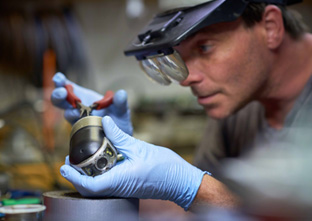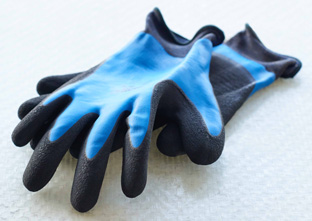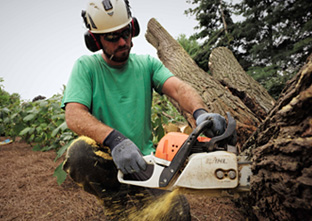Showa: Perfection at your fingertips

Although relatively unknown to the general public, the Showa brand is one of the world leaders in its field. What is the brand's history ?
Showa was born from the vision of a Japanese man named Akeo Tanaka. During the war in Manchuria, in the 1930s, Akeo Tanaka, like many of his countrymen, found himself on the front in rather extreme weather conditions. The cold was intense and caused many to lose fingers to frostbite, despite wearing rabbit-skin gloves. Once he was demobilised, he began working at a factory that produced PVC ink cartridges. Remembering the war, he looked for a way to protect his hands from the cold. He then had the idea of dipping an ordinary wool glove into a vat of PVC. In 1953, the first PVC glove came into existence. Later on, he founded Showa, a company that would forever change the work-glove industry.

Do you currently have a presence in all industries using work gloves ?
 Almost, although that is not our primary goal. The success of many Japanese companies such as ours is primarily based on the zero-defect principle. Our aim, therefore, is to only have a presence in a given industry if we are able to provide a product which perfectly meets the requirements of the industry. Our expertise is currently recognised in the industries of handling, cut-protection, chemical- and heat -protection, as well as those of antistatic and single-use gloves. The success of our products can also be attributed to our policy of continuous innovation. In fact, one of our mottos is "Never imitate, always innovate".
Almost, although that is not our primary goal. The success of many Japanese companies such as ours is primarily based on the zero-defect principle. Our aim, therefore, is to only have a presence in a given industry if we are able to provide a product which perfectly meets the requirements of the industry. Our expertise is currently recognised in the industries of handling, cut-protection, chemical- and heat -protection, as well as those of antistatic and single-use gloves. The success of our products can also be attributed to our policy of continuous innovation. In fact, one of our mottos is "Never imitate, always innovate".
Do you have a Research and Development Centre ?
 It is actually more than just that because we have completely mastered our manufacturing, design and inspection; we also create our own machines, our own fibres, some of our polymers and the moulds. We have also innovated in this last regard as our moulds reproduce the natural shape of a hand in the resting position. When they are moulded in this way, our gloves provide unrivalled comfort as they are truly ergonomic.
It is actually more than just that because we have completely mastered our manufacturing, design and inspection; we also create our own machines, our own fibres, some of our polymers and the moulds. We have also innovated in this last regard as our moulds reproduce the natural shape of a hand in the resting position. When they are moulded in this way, our gloves provide unrivalled comfort as they are truly ergonomic.
This unparalleled level of control also powers our innovation process. We develop inimitable products and technologies that give us a distinct advantage over our competitors. Coming back to our research centre, around one hundred research chemists work daily on the development of new polymers that have specific characteristics.
So you have no contact with the other major plastics manufacturers ?
Yes, of course we do, because we do not manufacture certain fibres, such as Kevlar. In fact, we have rather close relationships with the manufacturers whom we sometimes ask to work on the development of very specific fibres. We are fortunate to be producing very large volumes, and we are a major client for the chemicals industry. The latter provides us with advice and guidance for the development of new polymers. As an example, handling-operators in the automotive industry use a new pair of gloves every two days, on average. In the end, that accounts for several hundred thousand gloves per year.

Which polymers did you develop ?
 There are many. In the area of anti-cut gloves, we created our own fibre called Hagane Coil™. This patented fibre combines the Hagane stainless steel (the same as that used in the famous Japanese swords) with polyester and/or aramid fibres in order to provide high levels of protection against cuts. The gloves can withstand the pressure of a blade up to 45 Newtons (4,500 g). They are currently the only gloves on the market able to withstand such pressure. We also invented the world's first single-use nitrile glove. Nitrile, sometimes called nitrile rubber, is a polymer of the elastomer family which has all the characteristics of latex while also being hypoallergenic, which latex is not.
There are many. In the area of anti-cut gloves, we created our own fibre called Hagane Coil™. This patented fibre combines the Hagane stainless steel (the same as that used in the famous Japanese swords) with polyester and/or aramid fibres in order to provide high levels of protection against cuts. The gloves can withstand the pressure of a blade up to 45 Newtons (4,500 g). They are currently the only gloves on the market able to withstand such pressure. We also invented the world's first single-use nitrile glove. Nitrile, sometimes called nitrile rubber, is a polymer of the elastomer family which has all the characteristics of latex while also being hypoallergenic, which latex is not.
 We recently improved the material by making it biodegradable. We were able to combine the nitrile with organic materials that promote microbial activity and accelerate biodegradation. When it decomposes, it produces biogases and inert humus. Environmental sustainability is, in fact, one of our strongest values. In Japan, we set up a recycling system for PVC-coated nylon gloves. We organize the collection and we have developed a process for separating the nylon from the PVC. The latter is then ground and can subsequently be re-used in other objects.
We recently improved the material by making it biodegradable. We were able to combine the nitrile with organic materials that promote microbial activity and accelerate biodegradation. When it decomposes, it produces biogases and inert humus. Environmental sustainability is, in fact, one of our strongest values. In Japan, we set up a recycling system for PVC-coated nylon gloves. We organize the collection and we have developed a process for separating the nylon from the PVC. The latter is then ground and can subsequently be re-used in other objects.
After nearly twenty years of research, we have managed to combine apparently contradictory, although crucial, characteristics into a single glove: impermeability and breathability. We believed that breathability and the properties of impermeability could meet the needs of the agricultural industry. Workers in the industry often have to perform their duties in humid environments and generally feel a certain measure of discomfort given that their hands get wet during their work. We also launched the Temres glove. The glove uses technology based on the difference in size between water and water vapour molecules. Water molecules (in their liquid state) have a diameter between 100 and 3,000 µm, while the diameter of water vapour/humidity molecules is 0.0004 µm.

 Our engineers used this significant difference in sizes between the molecules to develop two main membranes for the glove: the first for breathability and the second for impermeability. More specifically, one of the membranes is made from porous polyurethane foam that helps evacuate moisture and enables the hands to dry off quickly. The second layer is on the outside and is made from a hydrophilic polymer which lets moisture molecules through while remaining impermeable to water.
Our engineers used this significant difference in sizes between the molecules to develop two main membranes for the glove: the first for breathability and the second for impermeability. More specifically, one of the membranes is made from porous polyurethane foam that helps evacuate moisture and enables the hands to dry off quickly. The second layer is on the outside and is made from a hydrophilic polymer which lets moisture molecules through while remaining impermeable to water.
What is the ideal work glove?
 t is a mistaken belief that good gloves must only meet the requirements of current standards and help users avoid the risks with which they are faced. The reality of the matter is far more complex than it may at first seem. Users must always be comfortable, regardless of their jobs, working conditions and the types of operations they carry out. Without this essential quality, safety would be considerably diminished. Firstly, any glove must perfectly fit a user's hand. The gloves must provide the best possible grip for tasks that require particular dexterity - in the event of handling slippery objects, the glove must have a specific grip in order to ensure the best possible adherence. Gloves have to be breathable and keep hands warm both while in use, inside and outside, whatever the ambient temperature. Finally, I would like to add that they have to be relatively affordable. We always strive to meet all of these requirements, and that is why we stay in regular contact with our clients. Their comments are very valuable to us, and they very often lead to innovation.
t is a mistaken belief that good gloves must only meet the requirements of current standards and help users avoid the risks with which they are faced. The reality of the matter is far more complex than it may at first seem. Users must always be comfortable, regardless of their jobs, working conditions and the types of operations they carry out. Without this essential quality, safety would be considerably diminished. Firstly, any glove must perfectly fit a user's hand. The gloves must provide the best possible grip for tasks that require particular dexterity - in the event of handling slippery objects, the glove must have a specific grip in order to ensure the best possible adherence. Gloves have to be breathable and keep hands warm both while in use, inside and outside, whatever the ambient temperature. Finally, I would like to add that they have to be relatively affordable. We always strive to meet all of these requirements, and that is why we stay in regular contact with our clients. Their comments are very valuable to us, and they very often lead to innovation.
MORE INFORMATION





